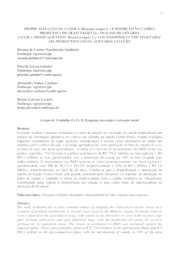Embrapa Trigo
 Busca de Publicações
Busca de Publicações
Tropicalização da canola (Brassica napus L.) e inserção na cadeia produtiva de óleo vegetal: análise de cenário.
Autoria: GUIDUCCI, R. do C. N.; SABAINI, P. S.; CARDOSO, A. N.; LAVIOLA, B. G.
Resumo: Resumo: O estudo avaliou o impacto econômico ex ante da adoção da variedade de canola tropicalizada em cenário de introdução gradativa do cultivo em safrinha na região Centro-Oeste. Foram avaliados impactos econômicos na etapa agrícola, considerando a canola como alternativa ao milho em safrinha após o cultivo da soja, e na etapa agroindustrial, com a produção de óleo de canola vis a vis ao óleo de soja, em áreas equivalentes. Avaliou-se o retorno do investimento em P&D frente aos ganhos esperados. Verificaram-se ganhos econômicos de R$ 776,4 milhões na fase agrícola e R$ 903,1 milhões na fase agroindustrial com a introdução de canola em 10% da área ocupada com milho safrinha. O investimento em P&D mostrou-se viável economicamente, nas fases agrícola e agroindustrial, com TIR de 98,1% e 101,2%, respectivamente e VPL de R$ 1,3bilões e R$ 1.6 bilhões, respectivamente, ao final de 20 anos. Conclui-se que a tropicalização e introdução da canola na região Centro-Oeste tem grande potencial para fortalecer os sistemas de produção de grãos da região e expandir a oferta de matéria-prima para a cadeia produtiva de oleaginosas, contribuindo para reduzir a dependência em relação à soja como fonte de matéria-prima na produção de biodiesel. Abstract: The study evaluated the ex ante economic impact of adopting the tropicalized canola variety in a scenario of gradual introduction in second crops areas in the Midwest region. Economic impacts were evaluated in the agricultural stage, with canola as an alternative to corn in the second crops after soybean cultivation, and agro-industrial stage, with the production of canola oil vis-à-vis soybean oil, in equivalent areas. The return on investment in R&D was evaluated against the expected gains. There were economic gains of R $ 776.4 million in the agricultural phase and R $ 903.1 million in the agro-industrial phase with the introduction of canola in 10% of the area occupied with second crop of corn. The investment in R&D proved to be economically viable, in the agricultural and agro-industrial phase, with an IRR of 98.1% and 101.2%, respectively and NPV of R $ 1.3 billion and R $ 1.6 billion, respectively, at the end of 20 years. It is concluded that the tropicalization and introduction of canola in the Midwest region has great potential to strengthen the grain production systems in the region, expand the supply of raw materials for the oilseed production chain and also contributing to reduce dependence on soy as a source of raw material in the production of biodiesel.
Ano de publicação: 2020
Tipo de publicação: Artigo em anais e proceedings
Unidade: Embrapa Agroenergia
Palavras-chave: Biocombustível, Bioeconomia, Brassica Napus, Impacto Econômico, Óleo Vegetal

